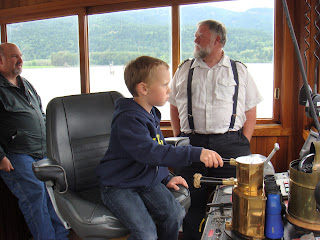We boarded the boat, and the staff pointed out our reserved table and a buffet with drinks and appetizers, but we just dumped our bags and scampered to the top deck, where we watched the riverboat leave the dock. People were shrugging into jackets and sweaters, since the Columbia River Gorge acts as a natural wind tunnel, being pretty much the only big pass through the Cascades.
The Columbia River is literally older than the hills. It was here when the Cascade volcanic mountains formed. When Ice Age glaciers melted and the ice dams broke about 15,000 years ago, the meltwater rushed through the river valley, scouring out this amazing, long gorge. The steep cliffs and tall waterfalls are standing proof of the power of that water. Today, the Columbia River is the second-biggest river in the U.S. by volume. The rock the water cut through is your basic volcanic basalt, the same stuff the ocean floor is made of. This stuff erupted in floods all over the eastern half of Oregon from 20-15 million years ago.
One side of the river is Oregon, the other Washington State. The big landslides happen on the Washington side because the rocks are stacked in layers, with thin soil layers in between. These rocks tend to slide like a stack of heavily buttered pancakes when the plate is tilted, according to my Roadside Geology book. On the Oregon side, the lava just squirted out all gloppy like toothpaste.
 |
| Gates closing behind us at the Bonneville Locks. |
 |
| The gates open so we can continue west along the Columbia. |
The Columbia River was a dangerous part of the Oregon Trail, and pioneers would make rafts and float down the powerful rapids toward Fort Vancouver. Now there are locks in place to tame the Columbia, and the passengers crowded the decks of our riverboat, watching as we cruised into a concrete box. Water was drained out of the box and the concrete cliffs loomed high on either side as we sank to the western river's lower level.
 |
| Dinner on the riverboat. That's an Old-Fashioned in front of me. |
The crew kept the food coming, and Benny stood at the bow, munching warm chocolate cookies and feeling life could offer nothing more. But it could -- I took him to visit the Captain, who allowed Benny to steer the ship! He set Benny in his chair and directed him to steer between buoys. Benny sat silently, his face screwed in concentration as we cruised past waterfalls.
 |
| Onenta Gorge |
The wind was getting colder. I dug out a hand-knitted hat I'd bought last December in San Francisco the day we went ice skating with Andy on the Embarcadero. Benny refused to leave the railing and Ron and I took turns standing with him.
| Beacon Rock |
We passed Onenta Gorge, a natural slot in the cliffs. More than 50 kinds of plants live in this always cool and moist shelter. Nearby were the spectacular 620-foot Multnomah Falls and on the Washington side was Beacon Rock, an 848-foot-tall monolith made of andesite, the ancient core of a volcano.
 |
| Multnomah Falls |
Finally, as we headed back to Cascade Locks we saw a big esprey nest built in a Coast Guard buoy. Every year the Guard has to clear out the nest, and every spring an esprey pair comes back, rebuilds the nest and raises another batch of chicks there. After visiting an esprey in the Raptor Center, Benny was happy to see one in the wild.
We arrived back at our hotel, tried but happy. The next day we planned to leave the Gorge and zip down I-5 again, headed toward Crater Lake.
 |
| An esprey and its nest on the Columbia River. |






No comments:
Post a Comment